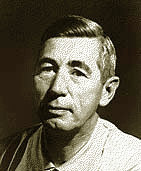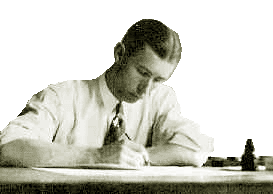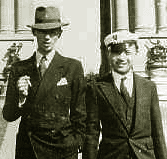


Interested in all was happening at the time, Hergé collected a century's worth of mythic and historic imagery. Through his illustrative art and narrative science, he gave the European comic strip its badge of honor.
1907 Georges Rémi is born in Brussels, Belgium, May 22.
1920 The young boy is bored to tears when he begins his studies at the Collège Saint -Boniface in Brussels.
1921 He receives the nickname "Curious Fox" when he joins the scout troop at his high school. His first drawings appear in Jamais assez, his school scouting magazine, and starting in 1923 in Le Boy-scout belge, the monthly magazine of Le Boy-Scout Belge (the Belgian Boy Scouts).
1924 From this point forward, Georges Rémi will sign his drawings with the name Hergé, from his initials "R.G." (as pronounced in French).
1925 His schooling now finished, Georges Rémi is hired as a worker in the subscription department by the newspaper Le Vingtième siècle
1926 He creates Totor, Leader of the Cockchafer Patrol (a precursor to Tintin) in Le Boy-scout belge.
1927 Georges Rémi performs his military duty.
1928 On return to Brussels, Hergé is named editor-in-chief of Le Petit vingtième, the weekly children's supplement to Le Vingtième siècle. The first issue is published on November 1.
1929 On January 10, Tintin and Snowy are "born" in Le Petit vingtième.

1930 He creates Quick and Flupke, the rascals of Brussels, who will appear in short self-contained stories in Le Petit vingtième. The first Tintin book is published: Tintin, Reporter, in the Land of the Soviets.
1932 Georges Rémi marries Germaine Kieckens, secretary to the editor of Le Vingtième siècle.
1934 Casterman Publishing House, based in Tournai, Belgium, becomes the publisher of the Adventures of Tintin. A meeting with a young Chinese student, Chang Chong-Chen, marks a decisive turning point. Hergé becomes convinced of the importance of a soundly built storyline and of the necessity for documentation. He begins to take seriously what was, until then, just a simple game.
1935 Hergé creates a new cast of heroes: Jo, Zette, and Jocko for the French weekly Coeurs vaillants. Five books will be published.
1939 As a result of the position taken by Hergé in favor of the Chinese people in The Blue Lotus, Tintin's creator is invited to China by the wife of Chiang Kai-Shek. The imminent war in Europe prevents the trip.
1940 On May 10, Belgium is invaded by German troops. The newspaper Le Vingtième siècle as well as Le Petit vingtième disappear. Tintin in the Land of Black Gold, the episode in progress, is suspended for eight years. Hergé begins another adventure, The Crab with the Golden Claws, which he publishes in Le Soir, one of the only newspapers authorized by the German occupation.
1942 Casterman Publishing House, aiming thenceforth to publish standardized books in full color (64 pages), asks Hergé to start adapting previous episodes to fit these new guidelines.
1944 The liberation of Belgium on September 3 ends the publication of the Adventures of Tintin in Le Soir. Some consider that by publishing in a newspaper controlled by the German occupation, Hergé has in fact "collaborated" with it.
1945 He continues the crucial work on his first books. They will be published one after the other according to the new guidelines.
1946 On September 26, the first issue of Tintin magazine is published. It is a new weekly created for young people by the old resister Raymond Leblanc.
1950 Having undertaken Explorers on the Moon, an episode requiring careful technical work as well as great documentary precision and extreme attention to detail, Hergé enlists a number of collaborators and founds the Hergé Studios.
1955 Tintin, whose stories are gaining more and more success, is popular enough to be of interest to advertisers. At the same time, Hergé develops a collection of "chromos" in which Tintin plays spokesman for different fields of knowledge.
1958 The episode Tintin in Tibet is completed despite the personal crisis.
1960 Tintin goes to the movies. Belgian Jean-Pierre Talbot plays him on the big screen in Tintin and the Mystery of the Golden Fleece. The actor will reappear in 1964 in Tintin and the Blue Oranges. Georges Rémi discovers modern art, and it becomes for him a source of true passion. He separates from his wife.
1969 The Studios Belvision of Brussels produce a full-length screen cartoon based on the book Prisoners of the Sun.
1971 On his first visit to the United States, Hergé meets some real native Americans.
1973 Casterman publishes the first volume of the Hergé Archives. Thus the mythical Tintin Reporter of Le Petit vingtième in the Land of the Soviets reappears more than 40 years after becoming unavailable. Hergé visits Taiwan, 35 years after the official invitation extended to him.
1976 The full-length documentary film I, Tintin, appears on screens. It is dedicated to the hero and his creator. On September 29, a bronze statue of Tintin and Snowy is inaugurated in Brussels.
1977 Having divorced his first wife, Hergé marries Fanny Vlamynck.
1979 The American Andy Warhol, king of Pop Art, makes a series of four portraits of Hergé. The "birth" of Tintin is commemorated a little bit everywhere. The 50 year life of Hergé's favorite hero is most notably celebrated by a postage stamp released by the Belgian Post Office, as well as by the Imaginary Tintin Museum and the book Fifty Years of Happy Work, etc.
1981 Hergé and Chang Chong-Chen are happily reunited. Chang was the Chinese friend who had inspired The Blue Lotus more than 45 years before.

1982 To celebrate Hergé's 75th birthday, the Belgian Astronomical Society names a recently discovered planet after him. Planet Hergé is located between Mars and Jupiter.
1983 On March 3, Georges Rémi (a.k.a. Hergé) dies.
1986 Publication of the book Tintin and Alpha-Art, the last and unfinished adventure of Tintin.
1987 Following Hergé's desire that Tintin not be given to another illustrator, his wife Fanny decides to replace the still-extant Hergé Studios with the Hergé Foundation.
1988 In a Brussels metro station, a 6 by 450 foot fresco is inaugurated; it depicts the cast of characters from the Adventures of Tintin, based on a sketch by Hergé. Tintin magazine is discontinued.
1989 In the National Center of Comic Strips and Pictures in Angoulême, France, a bust of Hergé is inaugurated, courtesy of Chang Chong-Chen. The Hergé Foundation erects a vast exhibit titled Tintin, 60 Years of Adventures. Inaugurated in Brussels, it is expected to tour the world.